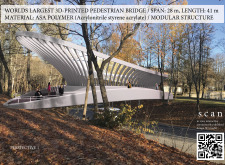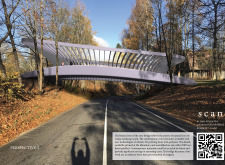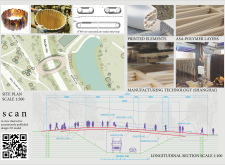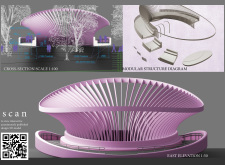5 key facts about this project
The design employs an innovative approach to architectural form, utilizing curvilinear lines that mimic natural shapes to create a seamless flow with the environment. This design decision not only addresses functional needs but also enhances the user experience by encouraging interaction with the surrounding natural context.
Material selection is critical in this project. The primary material used is ASA polymer (Acrylonitrile Styrene Acrylate), known for its durability and UV resistance, making it suitable for outdoor applications. Additionally, the project incorporates carbon fiber reinforced polymer (CFRP) tendons for structural tensioning, providing strength while keeping the overall weight of the bridge low. Modular components are included to facilitate easy transportation and assembly, further enhancing construction efficiency. This choice allows for the prefabrication of elements under controlled conditions, contributing to precision and reducing onsite disruption.
The unique curvilinear form of the bridge enhances both structural efficiency and aesthetic appeal. The design distributes loads effectively, optimizing performance under varying environmental conditions. The layered appearance created by overlapping ASA polymer layers adds visual depth and reinforces structural integrity. This attention to both form and function demonstrates a commitment to quality in architectural design.
Overall, this project exemplifies an adaptive approach to pedestrian infrastructure, combining sustainability with modernity. The careful selection of materials and innovative construction methods align with contemporary architectural practices, reinforcing the bridge's role as a functional and artistic addition to Gauja Landscape Park.
For further insights into the project's architectural plans, architectural sections, and architectural designs, please explore the detailed project presentation. Understanding the specifics of the design and the innovative architectural ideas behind it will provide a comprehensive view of this significant pedestrian bridge.


























